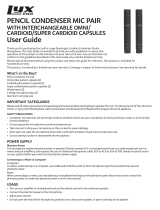
3
LARGE-DIAPHRAGM STUDIO CONDENSER MICROPHONE C-3
3.1 Cardioid
Microphones with this polar pattern (switch position: middle, )
are most sensitive to sound coming from in front of the
microphone, and also to a lesser extent from the sides. Sound
coming from behind the microphone will be greatly attenuated.
This makes the cardioid polar pattern most suitable for recording
individual instruments or vocals within a group.
3.2 Figure Eight
Microphones featuring the figure eight polar pattern (switch
position: left, ) are most sensitive to sound coming from either
directly in front of or directly behind the microphone. Sound
coming from either side or above / below is greatly attenuated.
This polar pattern is perfectly suited as a reporter mic for two
speakers. This pattern can also allow you to create a natural
reverb or delay effect. This is achieved by placing the
microphone between the sound source and a wall. The direct
sound reaches the „front“ membrane first, the reflected sound
reaches the „rear“ membrane a short time later. You can adjust
the delay / reverb time by changing the distance from the mic to
the wall.
3.3 Omnidirectional
If you use the C-3 with the omnidirectional polar pattern selected
(switch position: right, ), the microphone is equally susceptible
to sound coming from all directions. This polar characteristic is
particularly well suited to sessions in which a natural sounding
recording is sought, or when several sound sources surround
the C-3.
4. LOW CUT-FILTER AND SIGNAL LEVEL ATTENUATION
The low cut filter is activated via the left switch located at the
front of your C-3 (switch position: left, ). Disruptive, low-
frequency sounds such as subsonic noise, snapping and wind
sounds can be filtered out. When the low cut filter is active,
when recording a voice from a close distance, you get an almost
entirely linear frequency response.
The switch located on the front right side of your C-3 activates
the -10 dB signal level attenuation (switch position: right, -10 dB).
This function is particularly recommended when recording im-
pulse sound sources with high sound pressure (e.g. a bass
drum).
4. LOW CUT-FILTER AND SIGNAL LEVEL ATTENUATION






